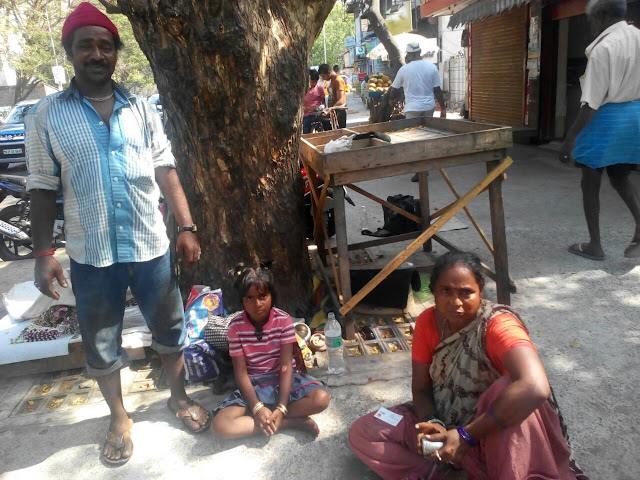On 9th May 2017,
myself and my colleague went for a evening walk in Besant Nagar, Chennai where we met a “Narikurava
family” ( a Nomadic Tribes ) who were busy with their means of livelihood by selling small fancy items like bangles,
hair pins, saree pins and combs
etc., on the platform. I have known this
family for more than five years as animal lovers.
The family consists of
father, mother and a female child. The
female child’s name is Thilothama, 10 years old and studying 5th standard
in a nearby school. Being a nomadic tribes, the husband and wife are uneducated
and homeless, their life and livelihood also on the platform, under a
tree. Though they are homeless but fond
of animals. They have provided shelter to the homeless animals and made them as
part of their family. Like parents, the
child is also fond of animals and loving them so much. Being a single female
child, she spends much of her time with the homeless animals. There is a strong emotional bond between the
child and homeless animals. She used to
talk and play with them.
When we were walking towards their
place the child identified me
from her place and running forward to me
and hold my hands
fondly and started
narrating the incident happened a few
days ago. While narrating the incident, she took a
small old model Nokia hand phone from her bag and showed us the photos of a
small new born squirrel. As the family
is living under a tree, they used
to hear the sounds of crows and squirrels
regularly and got familiar to that sounds. One day the sound was little different and unusual,
the squirrels made the sound
continuously. While hearing the sound,
she happened to see a newborn squirrel
was falling down near to her. She immediately took the squirrel and kept
it safely in her folded fingers with affection. The squirrel’s eyes were not
yet opened. Thereafter she started taking care of the squirrel. Every day she fed the squirrel with milk. The
squirrel started growing and moving here and
there. She happily played with the squirrel every day. After school timings she rushed to her place
and started playing with the squirrel. Even while sleeping, she kept the squirrel on her chest. Her
young world was rolling and moving with that squirrel only.
One day when she was
playing with the
squirrel in the platform and her parents were
doing their work,
two persons came to their place
and introduced themselves as
an animal activist
and a personnel of police department.
They enquired about the squirrel
and asked the family to handover it to
them. While enquiring, the animal activist and the
personnel of police department were ready to pay some amount of money to the
family in order to convince them.
But the parents and child begged
them that the they were not
willing to handover it and
wanted to take care of
it in their custody.
Finally they warned the family
to handover the
squirrel to the animal activists, otherwise
they would book
them under Animal
Cruelty Act. Also
they blamed the
family that “You
are a hunter, after some
time you will kill the
squirrel and eat
it”. At last, the innocent family with heavy heart handed over it to the
animal activist. After handing
over it, the
child didn’t have
her food and
crying for three days. The parents too were emotionally
disturbed and didn’t have their food for three days along
with the child.
I have known the family for more than five years. I always admired them
for their love, concern and
affinity with the homeless animals
in their neighbourhood. I have been
providing them with pet foods,
medicines and water bowls for their pets. Whenever I met them, we had long discussions
by sharing valuable information about pet animals and the importance of their child’s education. During my interactions with them, I used to admire their unconditional love and passion towards
the homeless animals. When the child was narrating
this incident to me, her eyes pooled
with tears, even her mother too.
The innocent father
asked me, “Sir,
don’t we have
any rights to
rearing even a
small squirrel?”. “We are
homeless”. “We are uneducated and
voiceless”. We always feel
that these homeless animals are also like us. That’s why we love each other.
In this world, as
a nomadic tribes, we
feel being loved
by our pets
only with unconditional
love and loyalty. We too love them unconditionally with compassion. We
believe and treat our pets (dogs) as
our god “bairava” who protects us
against all evils. While listening
to them, their hopeless voices made me more painful. That pains took me
to many sleepless nights These
sleepless and disturbed nights
made me to think more and
more about the incident and
the factors which
are responsible for constructing the mindset ( psyche) of
people to perceive
that the nomadic
tribes are cruel,
unsocial and uncompassionate.
As a whole, animal activists don’t
take the law in your hand without analyzing the facts and others point of view.
Just because of she belongs to Narikurava family doesn’t she have the right to have the pets? Can you give answers for Thilothama family’s questions
?.
Don’t make others a victim and animals to suffer
in the name of animal rescue for your face book posts.
-Jerold



